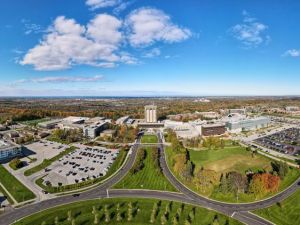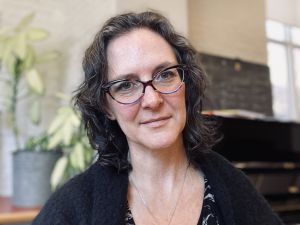Brock Biological Sciences Professor Liette Vasseur is helping municipalities to mitigate damage to their shorelines and plan for a more sustainable future.
Vasseur is part of a Great Lakes and St. Lawrence Cities Initiative called the Mayors Advisory Council on Coastal Resilience. The council was established to work with mayors of municipalities on the Great Lakes and St. Lawrence River on both sides of the Canada-U.S. border to develop recommendations on how to mitigate the considerable damage to their shorelines caused by erosion, flooding and other impacts, and adapt to increasing water level fluctuations and other extreme weather events.
The council’s meetings provide a useful forum to both educate and spread awareness of issues that residents may not be aware are affecting their localities, Vasseur said.
“Preventing or minimizing environmental disaster in an area through a nature-based solution that uses ecosystem-based adaptation is something of interest for the mayors,” she said. “Residents are often unaware which options exist, including those that can be more effective and may have a longer lasting impact on erosion prevention.”
While the advisory council is not a policy-making body, it advises the Great Lakes and St. Lawrence Cities Initiative’s member mayors on policy position considerations for the organization.
One of the core policy recommendations is to advise when “green” versus conventional “grey” solutions can be applied.
“We have been studying coastal regions that are sensitive to hazards such as strong waves and ice jams, as well as sea level rise on the east coast due to climate change,” Vasseur said.
In some cases, vegetation can be used to support and protect areas as well as “manage the ecosystem to adapt to new environmental pressures and thrive,” she said. “In other cases, it is time to retreat.
“We are hearing from the council mayors that all cities along the Great Lakes and St. Lawrence have pressure to further develop along the shore and coastline,” Vasseur said.
Housing developments are pushing buildings closer to the coastlines due to lucrative property values, and there is financial pressure to build right to the water’s edge. At the same time, climate pressure and erosion are shrinking the inhabitable portion of a healthy sustainable shore.
“One of the reasons we are seeing coastal erosion is the changing weather patterns, with more storms and wave action,” said Vasseur. “Water in the Great Lakes is also warming up. We know this has led to increased levels of algae bloom in the water like we have seen in Lake Erie.”
Higher water surface temperature also leads to increased evaporation, which brings more clouds and rain.
Vasseur said increasing water temperature in the winters can cause erosion through ice damage.
“Shores and coastlines are dynamic and are changing all the time. Erosion can happen rapidly to softer shores,” she said. “With winters being warmer, the ice that usually covers the entire lake is not there anymore. Under normal circumstances, with a totally or almost totally frozen lake, a large storm with high winds does not move the ice around. Yet now, because the ice is only along the coast and often thinner, large waves on open water push the ice against the shore, which can damage and erode shorelines.”
Vasseur said municipalities “have to start working together to sustain the coastline.”
Educating residents on the dynamisms of coastlines, the value of adaptation and the use of green alternatives is important, she said, adding it is a common misconception that building a concrete wall or similar “grey” solution is the only way to fight erosion.
Coastline sustainability relies heavily on all parties along the shore working together to solve the issue, Vasseur said.
Building a retaining wall on a resident’s property has little benefit if the neighbours on either side do not install them as well. Eventually erosion on the neighbour’s side will advance past the retaining wall and still erode the property with the retaining wall, she said.
Sustainable efforts to avoid erosion might include tree planting along the coastlines, routing drainage water to flow away from problem areas, or combinations of rock and nature-based installations and blockades to protect against waves and ice.
“We need to think about how to use nature as a buffer,” Vasseur said.
Moving from “grey” to “green” solutions and uniting residents, municipalities and even countries together in the decision-making process provides the best chance for a sustainable solution, which will most likely be a combination of various approaches, she said.
“Professor Vasseur’s dedication to environmental protection has helped educate a vast number of organizations to plan for a more sustainable future,” said Faculty of Mathematics and Science Dean Ejaz Ahmed. “Our environmental future depends on the quality of decisions we make today.”










